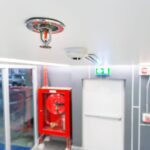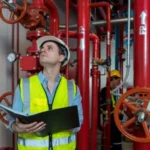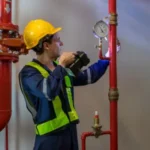Keeping your building protected from fire isn’t simply installing alarms and sprinklers, but making sure they work when necessary. Having a proper fire protection maintenance program helps to eliminate unintended costly surprises and keep everyone safe in your building. It is also your best way to protect against failures, fines, or worse, a preventable disaster.
Here we will review your important maintenance tasks that you should not overlook.
1. Give Your Fire Sprinklers the Attention They Deserve
Your fire sprinkler system is your building’s first line of defense when things go wrong. Although they are often inactive, when temperatures rise, they will literally “spray” into action.
Over a period of time, pipes might corrode, valves may “stick,” and heads can become clogged up with dust and/or items “stored” too close to them. Following a quick in-house inspection every month and a yearly inspection by a professional will help to keep them operational.
Make sure all valves are open, your water pressure is adequate, and that there is nothing hanging too close to the heads.
2. Don’t Ignore Your Suppression Systems
If you have sensitive areas like server rooms or labs, chances are you’ve got a fire suppression system in place instead of (or alongside) sprinklers. These rely on chemicals or gases to smother flames without ruining your equipment.
Because suppression systems are so specialized, check that their gauges show proper pressure, and have a technician verify all sensors and release valves at least once a year. The hardest part is remembering these systems are “out of sight, out of mind”—so make them part of your regular safety rounds.
3. Inspect Fire Extinguishers Like Clockwork
Everyone has seen a fire extinguisher, but often doesn’t check them. A fire extinguisher inspection is one of the easiest safety measures, but it is also one of the most overlooked. Here is a quick checklist when you check extinguishers: the pressure gauge is in the green zone, the safety pin is intact, and there are no rust or dents, or signs of wear or damage. Additionally, every staff member should know where fire extinguishers are located and how to use them properly. Every year, your fire technician can recertify them, so they are always ready to go.
4. Test Fire Alarms Regularly—Not Just Once a Year
An operational alarm system can often mean the difference between a managed fire and a total disaster. Fire alarm testing should take place on a schedule; basic checks each month, and full-service testing each year.
Make sure that signals from the alarms reach your monitoring company and that audible signals are clear to hear in the building. Backup batteries and emergency lighting are also important features, and it is often the small details that we overlook until the power goes out.
5. Keep Every Piece of Fire Safety Gear in Shape
Emergency lights, emergency hose reels, or safety exit signs may seem inconsequential, but all of this fire safety equipment counts when it becomes chaotic. Lights need to be illuminated when the electricity goes out, and all exit pathways must remain clear and visible.
A quick test takes a few minutes but has the potential to save lives during evacuation. Identify a date on the calendar each month to test & check batteries, bulbs, heat, accessibility, etc.
6. Bring in the Pros When Needed
Some maintenance tasks aren’t DIY-friendly—and that’s okay. Calling in local experts who offer fire protection services ensures inspections, testing, and documentation are handled the right way. Certified technicians catch issues you might miss, update your compliance records, and make sure your systems meet local codes and insurance standards.
7. Review the Entire Fire System Layout
Buildings get remodeled, equipment moves around, and shelving changes height—all of which affect fire coverage. Review your fire protection system at least once a year with your safety provider.
Something as simple as a blocked sprinkler or relocated smoke detector can limit coverage and create hidden blind spots. Keeping digital or printed layouts helps track changes and identify missing protection zones.
8. Keep a Maintenance Log and Share It
If you’re not documenting your maintenance, it’s like it never happened. Keeping detailed logs shows inspectors you’re doing your part and makes it easy to track what’s been tested or repaired.
Include inspection dates, who performed them, test results, and replacements made. Having this record in one place can save a lot of headaches during audits or insurance reviews.
9. Train Your Team to React Fast
No system works if people freeze during an emergency. Train your staff regularly on how to respond when alarms sound, where extinguishers are, and what exits to use. Even a short refresher once a quarter builds confidence and keeps safety procedures top of mind.
10. Be Preventive, Not Reactive
Waiting for something to break before fixing it costs more—and increases risk. Preventive care is about consistently checking, testing, and updating. Whether it’s replacing worn gaskets in sprinklers or swapping dead batteries in alarms, small actions now prevent expensive failures later.
Prevention keeps your safety network resilient and ensures that every piece of equipment responds the moment it’s needed.
A Final Word
A well-maintained fire safety system doesn’t just protect your property—it protects people. It’s peace of mind for everyone under your roof. From sprinklers to alarms, each element works together to create safety that’s invisible until the moment it matters most.
Stick with a clear maintenance schedule, team up with qualified professionals, and never skip those routine checks. It’s a small effort that pays off in the biggest way possible: saving lives.
FAQs
1. How frequently should fire protection systems be inspected?
The majority of systems should be inspected by a certified professional at least once or twice a year. However, small checks like making sure sprinklers are not obstructed and extinguishers are easily accessible should be done every month.
2. Why do fire sprinklers need to be tested regularly when they are rarely activated?
Although your sprinklers may not have been activated in the past, they still may rust, leak, or get blocked by dust or debris. By testing them regularly, you can feel secure in knowing that if a fire were to occur, your sprinklers would release the water when heat is detected.
3. Can I conduct my own fire safety inspections?
You may be able to carry out simple visual inspections, but a complete system conducting testing itself should always be monitored with a licensed technician. Technicians and professionals have the necessary tools and knowledge to observe alarms, valves, and pressure monitoring safely.
4. How can I tell if my fire extinguishers are still good?
By checking that the pressure gauge is in the green range, the seal is not broken, and the equipment is not visibly damaged. Fire extinguishers typically also require a licensed technician inspection once a year, and recharging after each use.







